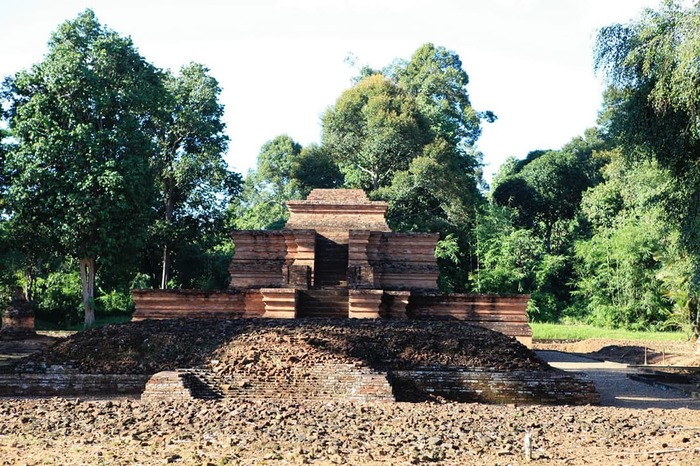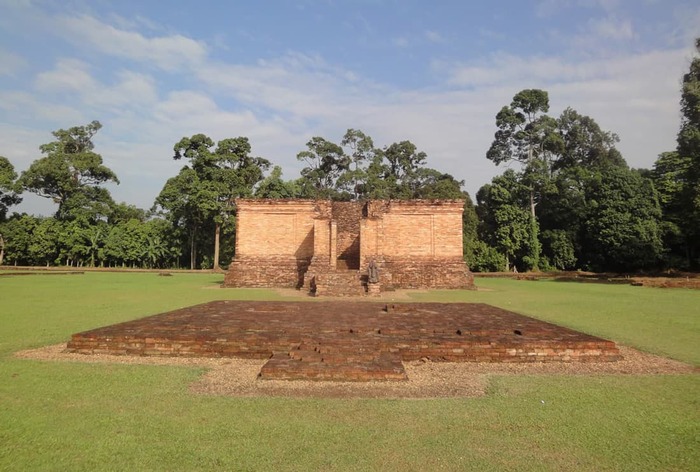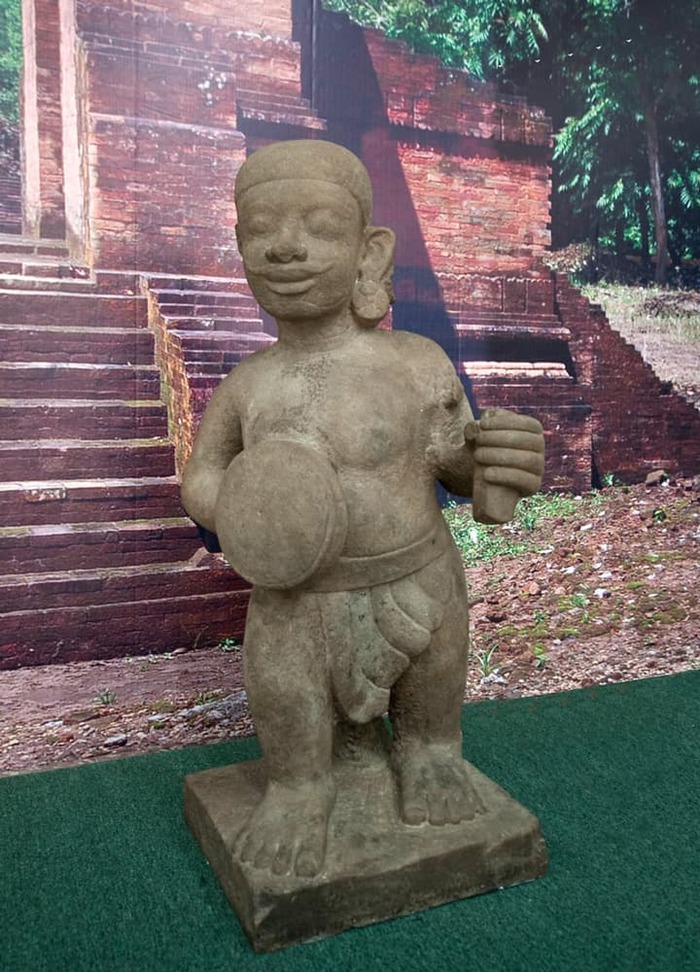In the year 671 CE, the Chinese pilgrim Yijing (I-Tsing) leaves the port of Canton on a Persian vessel to visit India and study Buddhism. Remembering Xuanzang (Hsüan-Tsang), the famous monk and translator who died some years before, gives him the courage to venture into this dangerous journey. But unlike his compatriot, Yijing does not travel on the famous continental Silk Road. The demand for Chinese silk is falling, due to Byzantium having successfully developed sericulture since the year 551. In addition, the continental Silk Road has become increasingly dangerous: from the early 7th century, Arab military campaigns block the overland road through Persia. Trade between China and Sindh (currently a province of Pakistan) is interrupted because of the incessant wars in Central Asia between the Arab Umayyad dynasty, the Chinese Tang Dynasty, the Tibetans and the Eastern Turks. Goods and Chinese pilgrims therefore have now to travel by sea through the Strait of Malacca, already one of the main lines of international trade.F
Yijing will emerge as the first chronicler of this new sea route, which will also be that of Buddhism. In his travel account translated in English in 1896 by Junjiro Takakusu's under the title: A Record of the Buddhist Religion as Practiced in India and Malay Archipelago, A.D. 671–695, he reports that after twenty days at sea, Yijing stopped in a unknown fortified city located on an island that he calls “Fo-Che”:
In the fortified city of Fo-Che, (lived) Buddhist monks numbering more than 1,000, whose minds are bent on learning and good practice.
After nine years at Nalanda, a city that hosted the largest Mahayana Buddhist monastic university of its time, in the present state of Bihar in India, Yijing returns twice to this mysterious island kingdom of Fo-Che, which he also calls “San-fo-ts'i” or “Mo-lo-yeu.” Yijing writes,
They (the monks in Fo-Che) investigate and study all the subjects that exist just as in Middle Kingdom (Madhya-desa, India).
This indicates that subjects such as logic, grammar and philology, medicine, arts, as well as metaphysics and philosophy were taught in Fo-Che. According to his records, he copies there hundreds of Sanskrit manuscripts, before finally returning to China in 694.
Where was this mysterious kingdom of Fo-Che? The puzzle will remain unsolved for more than twelve centuries. In 1918, the French epigraphist George Coedès finally identified Fo-Che or San-fo-ts’i as the kingdom of Srivijaya centered in Palembang, Sumatra. In the1980s, archeological excavations confirmed that the river port of Palembang was indeed the political and military capital of this powerful kingdom facing the Malacca strait, on the confluence of maritime trade between India, China and the Middle East. Despite the discovery of a colossal statue of Buddha on a hill in Palembang, there was however no evidence probative of a great center of Buddhist learning, which Yijing compared to Nalanda.
In the 18th century, Dutch officials of the East India Company (VOC) had noted north of Palembang, in the heart of a lush forest and the hot haze of the equator, about thirty kilometers from the mouth of Batanghari, the longest river in Sumatra, a huge archaeological site covering both banks: Muara Jambi (often referred to by the present name of the regency in which it is located, Muaro Jambi). Excavations started from 1970 by the Indonesian government have established that this extraordinary site, which spreads over more than 2,000 hectares, encloses 84 red-brick “temple complexes” - locally called “menapo”- connected by an ingenious system of canals. Eight of these “temple complexes” have been excavated, with several statues and many pieces of Chinese pottery and ceramics from the 9th to the 12th centuries. But since very few epigraphs attesting to any written transmission of knowledge have been found so far, archaeologists still do not dare to speak openly about a “university.” Yet they admit that these complexes were not temples, but study centers with two to six podiums each, once sheltered from the sun and rain by a tiled roof supported by wooden pillars. The student monks would be sitting cross-legged around the podium on the brick pavement.
As a matter of fact, the entire design and layout of the Muara Jambi complex is very similar to those of Nalanda, where monks lived in a cluster of buildings that were fortified or walled in accordance with the vinaya, monastic rules. Hence, the “fortified city” mentioned by Yijing was most probably referring to the complex of Muara Jambi.

Three and a half centuries later, another travel record corroborates that of Yijing: An Account on Meeting with Master Serlingpa Chokyi Dakpa. It is written in Tibetan in the first person by Atisha, a prominent Indian Buddhist master. Atisha was born in the Land of Zahor (nowadays near Dhaka, Bangladesh) in 980 as the son of King Kalyana, and was named Prince Chandragarbha. In his teenage years, Atisha left his kingdom and wandered through forests and mountains seeking knowledge from masters living in the wild or in the monastic universities of Nalanda and Odantapuri. At the age of 29, he received the Buddhist monk ordination and was given the name Dipamkara Srijnana, “He Whose Glorious Deep Awareness Acts as a Lamp.”
Song 132 of Atisha’s Tibetan biography (rNam-thar rgyas-pa, written around 1355) says,
Atisha’s most important master was Serlingpa, also known as Dharmakirti, whose fame was widespread. Atisha had already heard about Serlinga’s teachings on compassion and bodhichitta and he was sure that Serlingpa had been his most precious teacher for infinite lives.
With 125 students and a group of merchants seeking gold, Atisha put to sea. So says Atisha’s account:
Homage to Maitreya and Avalokiteshvara! I, bhikshu Dipamkara Shrijnana, travelled by ship for thirteen months and went to where Lama Serlingpa was. After five months had passed, the Son of God Indra sent great storms to stop me from continuing my mission of bodhichitta. Also, he appeared in the form of a giant makara to stop me and sent lightning. At that time, I did an intensive meditation on Love and Compassion. As a result, the storm calmed down and six huge lightnings were seen stuck up in the sky unable to fall down. However, the makara managed to stop our way. At the same time, the violent wind caused our ship to become very unsteady, the way it happens to flags in violent wind; shaking, wavering, bobbing up in the air and sinking down in the ocean. The four masts in the four corners were laid down and the four big stones were downed to anchor the ship. But the atmosphere turned even more scaring; terrible sounds blared from all the four corners followed by lightning…
After fourteen months on sea, Atisha crossed the Strait of Malacca. He landed on the famous "golden island," Suvarnadvipa as it is called in Sanskrit. George Coedès identified this isle as being that of Sumatra. Many historians and archaeologists subsequently confirm the thesis of the French epigraphist. The western regions of Sumatra were indeed known at the time to be very rich in gold.
Today, the mouth of the Bantaghari River, Muara Sabak, is actually just a pier. The ocean is still far away, at least two hours by boat, but the land stops here, where the river divides into two branches. The two arms encircle an island that looks to the Malacca Straits, guarding the river’s entrance. This fluvial island hosts a national park with lots of crocodiles and mangroves. Just as in Atisha’s account:
As soon as we crossed the ocean, I (Atisha) went straightaway to the golden stupa the Tibetan emperor had built once upon a time. It was there that the six disciples of Lama Serlingpa were engaged in samadhi. This stupa was located to the west of the forest of Suvarnadvipa, to the south of the joyful lotuses, to the north of the dangerous mires, and to the east of the Crocodile Kekeru. I stayed there for fourteen days, making inquiries about the life of Lama Serlingpa.
A number of descriptions in the account of his journey suggests that it is in Muara Jambi that Atisha met Serlingpa and study with his dearest master, such as the large number of monks who lived there and the excellence of Buddhist texts that were taught there:
Then I (Atisha) saw the bhikshus coming from a far off distance in procession following their master. They were well dressed in their three robes. Each one was holding a water container and a staff. There were five hundred and thirty-five in number and looked as gracious as arahats. The master was attended by sixty-two sramaneras. In all there were a total of five hundred and seventy-two monks. As soon as I saw this, I felt as if I was seeing Buddha surrounded by arahats. What a pleasant scene it was! …
Then we went to Lama’s residence, the Silver Parasol Palace, and took our seats... After we had settled there, the Lama in order to introduce to me the characteristics of ‘dependent origination’ began his teachings from the ‘Abhisamayalamkara’ in five sessions. Staying in the Silver Parasol Palace, I continued with my practices of listening, concentration and meditation. Lama Serlingpa guided me throughout this process of practice.
In 1025, entrusted with the precious teachings of Serlingpa, Atisha sailed back to India, just before the Chola Kingdom from South India attacked Srivijaya. He settled at Vikramashila Monastery. In 1041, the king of West Tibet, Yeshe Ö (Ye-shes ‘od), invited him to reinstate all aspects of Buddha’s teachings – Theravada, Mahayana and Vajrayana – as complementary. Atisha stayed thirteen years in Tibet and died in Tibet in 1054. His most famous teaching is A Lamp for the Path to Enlightenment (Byang-chub lam-gyi sgron-ma, Skt. Bodhipathapradipa), which served later in Tibet as the basis for the lam-rim graded stages genre, a textual form that, like a butter lamp lighting up in the storm of life, summarizes the main points of all the teachings of the sutras in a progressive order. Atisha had many masters, but all his biographies report that, at the mere mention of Serlingpa, his eyes filled with tears. He said that all the goodness he had, he owed to his master of the Golden Island.

One still wonders why Muara Jambi has sunk into oblivion after the 13th century. Some scholars mention the attack of the Hindu kingdom of the Cholas in southern India, which wanted to take control of the lucrative and strategic Straits of Malacca. But this assault, which would put an end to the power of Srivijaya, occurred in 1025. However, one of the most beautiful statues discovered in Muara Jambi is a Prajnaparamita dated from the 13th or 14th century. Other scholars suggest that the Mo-lo-yeu Kingdom recorded by Yijing and where Muara Jambi is located was a vassal, a competitor or "a matrix" of the Cholas, and as such was saved from the Cholas attack and boomed after the fall of Srivijaya. Unlike the large Indian monasteries of Bihar that were laid to ruins by Turkish and Afghan raids, Sumatra and the entire Indonesian archipelago did not experience Muslim invasions. The sack of Muara Jambi – if it ever happened – cannot be attributed to Islam, which is the dominant religion in the region today.
On the very site of Muara Jambi stands a village whose inhabitants are all Muslims. Their homes are made of wood and built on stilts along the Batanghari River. Their orchards planted with cacao and durian trees extend on the ruins of the temples. Several young villagers occasionally work on excavations under the supervision of the archaeologists. They can identify each stone, each mound of red earth, every tree in the forest where their parents have small huts to watch the fall of the durians at night. They can point out several endemic species of trees from the Indian subcontinent that grow nowhere else in Sumatra, except in the forest of Muara Jambi. For instance, the kapung tree or kembang parang (Tib. metog dzambaka) whose white film-like petals inside the bark is used in India and Tibet as flower-offereings in tantric initiations.
Archaeologists have not yet been able to unravel the mystery of these 84 mysterious temple complexes surrounded by walls and canals, many of which are still piles of ruins and earth mounds in the middle of the orchards and cocoa plantations of the villagers, so they’ve adopted the local term “menapo” for them. “Napo” in the language of Muara Jambi means “deer” and “me” means “location.” During the annual floods of the Batanghari River, which submerges the village under more than a meter of water, the menapo is the high location where wild animals from the forest take refuge like on Noah's ark. The young villagers themselves are convinced that the 84 temple complexes were in fact faculties and that Muara Jambi was the first green university for Mahayana Buddhism in Indonesia. At the crossroads of India and China, its campus encompassed the rain forest which was used as an orchard, a library, a living pharmacy and a haven for meditation:
"We understand that the essence of Buddhism is to put others before oneself,” say the young villagers.

They have founded a community center and a green school, Saramuja, to excavate in their own way the ancient history of this forgotten site and transmit to the village children the local culture and the sense of respect for the environment. More recently, they’ve organized themselves into a larger community center, the Padmasana foundation to professionalize their research and share it more widely. Their symbol is the Dvarapala, the gate keeper of Hindu or Buddhist temples, which is traditionally presented in a fearsome appearance. But the statue of Dvarapala discovered in a temple of Muara Jambi, if properly armed with a small shield and a broken mace, is smiling and wearing a flower on his ear.